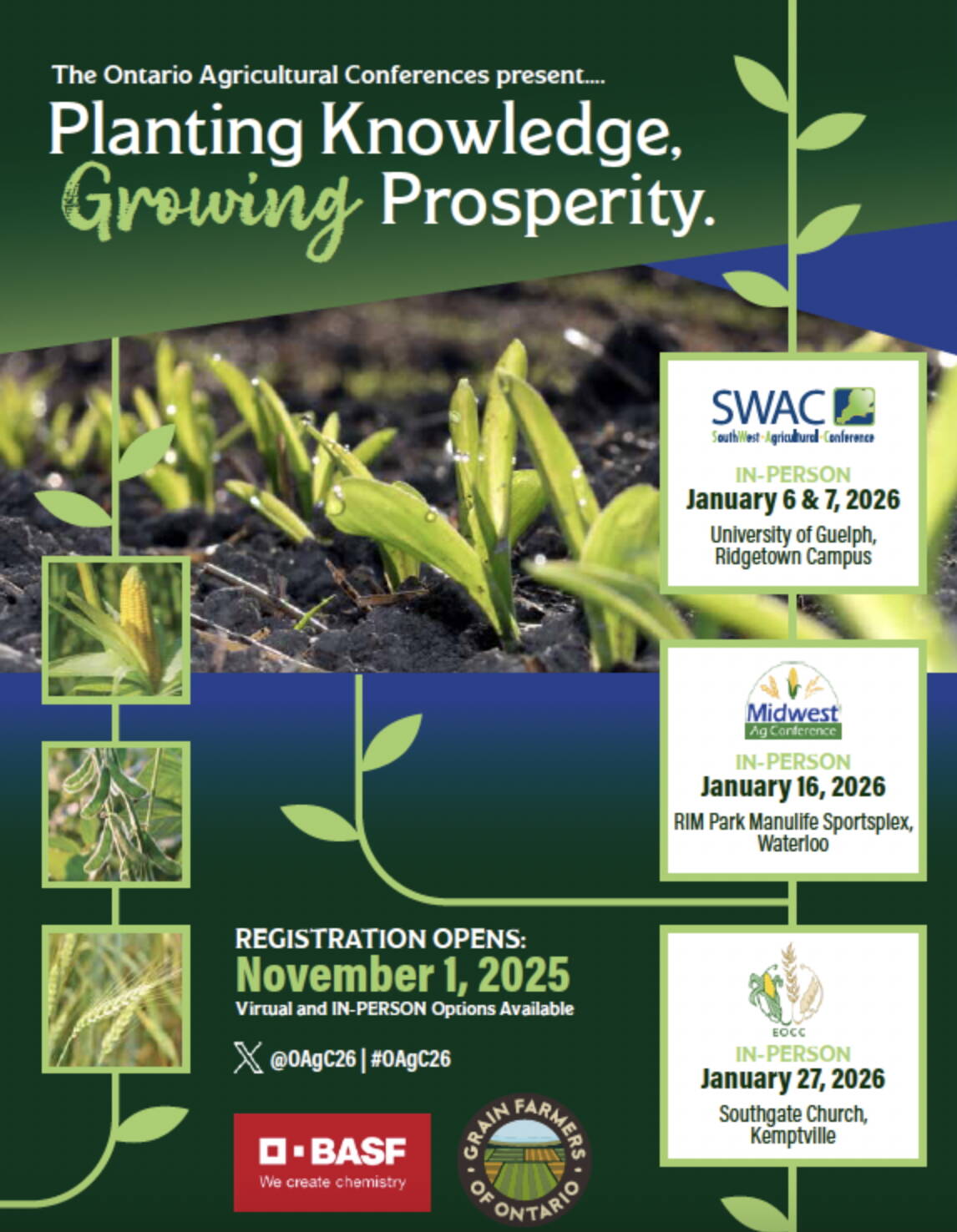The Ontario soybean harvest was about 85 per cent complete and corn progress stood at 70 per cent as of Nov. 14. Some areas had a significant amount of corn out in the field, but given weather forecasts, harvest should be wrapped up by Nov. 28.
Quick look
Soybeans: Weather problems likely to affect Brazilian soybeans, so China will be an aggressive buyer of U.S. stocks in the spring.
Corn: Brazilian conditions will have a large influence on the corn market.
Wheat: Winter wheat acreage in North America has decreased due to lower prices.
We anticipate a year-over-year decrease in winter wheat acres and conditions are variable across the province. Harvest selling pressure, along with limited export demand, has weighed on the corn market. Soybean prices appear to be percolating higher due to an increase in offshore movement. Healthy soymeal values have supported the domestic crush margin structure.
Read Also

Registration open for Ontario Agricultural Conference
The Ontario Agricultural Conference 2026 offers in-person and online access to expert insights, hands-on learning, and networking opportunities.
Wheat prices are up about 50 cents per bushel from the September lows. Strong competition in the export market has tempered the upside for Ontario wheat values. We advise farmers to increase their sales for wheat.
U.S. farmers are in the final stages of harvest. The November World Agriculture Supply and Demand Estimates (WASDE) report was considered slightly negative for the corn and soybean markets due to an upward adjustment to yields. The report was a non-event for the wheat complex.
As of Nov. 14, we estimate that Brazilian farmers have planted 55 per cent of the soybean crop and 50 per cent of the first corn crop. Brazil continues to contend with excessive precipitation in the south and abnormal dry and hot conditions in the central and northern regions. This is bullish for the corn market longer term.
The Argentine corn crop was 28 per cent planted as of Nov. 14. Russia continues to dominate the world wheat market. Traders have bumped up their Australian production forecasts and the harvest is moving into full swing.
China continues to be a major importer of wheat. India will be a net wheat importer in the 2023-24 crop year. North Africa is contending with drier conditions. Germany and France are experiencing favourable rains and crop conditions have improved in the U.S. Southern Plains.
The Bank of Canada held its policy rate at five per cent on Oct. 25, while the U.S. Fed kept its benchmark rate at 5.5 per cent on Nov. 1. The U.S. economy is experiencing slower growth in the fourth quarter and will likely contract in the first half of 2024.
Canada is technically in a recession. Inflation has eased but remains above the two per cent target. Wage growth remains elevated. The money supply is tightening. We believe the tightening cycle from the Bank of Canada is over and the Fed is likely at the end or close to it. This environment will keep the Canadian dollar rangebound with downside risk.
Soybeans
We expect Ontario farmers to deliver three million tonnes of soybeans into the elevator system between Aug. 1 and Dec. 31. However, the bulk of the volume will be delivered by the end of November, which will also give the market breathing room to move higher in December.
Currently, bids from the domestic crush are equivalent to the export market and on certain days, we actually see export bids above the local crusher.
Ontario soybean exports from Aug. 1 through Dec. 31 are estimated at 1.5 million tonnes and domestic usage is 600,000 tonnes. The bulk of the exports occur in late October, November and December. This is prior to the start of the Brazilian harvest.
In the domestic market, we have seasonally strong export demand as farmer selling eases, resulting in higher prices.
A weather problem is developing for Brazilian soybeans. The southern region has experienced excessive precipitation, delaying planting progress. Industry comments suggest that some soybeans will have to be replanted.
The reverse is occurring in the central and northern regions, which are experiencing above average temperatures and below normal precipitation. There is severe crop stress. It’s too early in Argentina to assess overall crop conditions because planting and crop development are in the early stages.
The USDA made an upward adjustment to the U.S. soybean yield on the November WASDE report. The change translated into a 25 million bushel increase to the 2023-24 ending stocks. Traders viewed this as a minor adjustment to the fundamental structure.
Brazilian and U.S. export values are up US$25-US$30/tonne from two weeks ago. The world market is incorporating a risk premium due to uncertainty in production. Major buyers like China will be more aggressive for U.S. soybeans later in winter due to the problems in Brazil.
Argentina is a secondary exporter of soybeans as the domestic market is focused on crushing. It is the world’s largest soymeal exporter in a normal year. This has ramifications for next spring.
What to do: We’ve advised Ontario farmers to be 40 per cent sold on their 2023 production. The soybean market needs to strengthen so we see a three to four million year-over-year increase in U.S. soybean acres next spring. Secondly, the world soybean market cannot afford a crop problem in North America next summer. This market environment favours waiting to make additional sales.
Corn
Continued delays in the Ontario corn harvest caused traders to trim their yield estimate. Farmer deliveries into the commercial system have been slower than anticipated. The crop will still finish around 10 million tonnes, up from the 2022 crop of 9.4 million tonnes. The market is functioning to encourage demand. Export movement appears larger than earlier anticipated as values are competitive on the world market.
Domestically, cattle on feed inventories increase during the fall and make a seasonal high in January. Ethanol margins are favourable, enhancing demand from the energy sector.
U.S. corn has taken the dominant position in the world market. U.S. offers f.o.b. the Gulf are US$8-US$10/tonne lower than Brazil and Argentine values. U.S. export sales are running nearly 30 per cent ahead of last year’s pace. Lower prices have encouraged demand.
The USDA increased the U.S. yield on the November WASDE report. The net result was a 45 million bushel upward revision to ending stocks. U.S. corn ending stocks for the 2023-24 crop year are projected to finish near 55 million tonnes, up from the 2022-23 carryout of 35 million tonnes and up from the five-year average of 45 million tonnes.
Brazilian conditions will have a large influence on the corn market. Brazil’s first corn crop will be down from year-ago levels as farmers intended to increase soybean acres. The second corn crop, known as the Safrinha production will be planted later than normal and acres will be down from earlier projections.
Traders now estimate the Brazilian corn crop at around 115 million tonnes, down from 2022-23 crop of 137 million tonnes. The Argentine carryout from 2022-23 was at bin-bottom levels and upcoming production remains uncertain. The U.S. will be the main seller of corn through May 2024.
Next spring, the market is battling against soybeans for acreage. The USDA baseline projection had the 2024 U.S. corn area down by three million acres from 2023. The lower acreage will make the corn market extremely sensitive to weather and yield forecasts during the summer of 2024.
What to do: We’ve advised farmers to be 40 per cent sold on their 2023 production. Let’s see how Brazilian conditions materialize before making further sales. Lower U.S. acreage in 2024 should result in higher prices in the latter half of the 2023-24 crop year. The market will likely incorporate a risk premium due to the uncertainty in Brazilian and U.S. production.
Wheat
Ontario farmers harvested 2.6 million tonnes of wheat, up from the five-year average of 2.1 million tonnes. Farmers will deliver 2.1 million tonnes into the commercial system between Aug.1 and Dec. 31. We’re estimating on-farm stocks as of Dec. 31 at 500,000 tonnes.
The Ontario wheat market has been functioning to encourage export demand. Domestic millers have the bulk of their requirements covered for the next four to six months. In our previous issue, we mentioned that Ontario farmers were expected to decrease wheat acres by 20 per cent.
U.S. farmers sell 50 per cent of their winter wheat during the summer and 25 per cent in the fall. The bulk of the U.S. soft red winter has been absorbed into the commercial system. Lower prices have discouraged U.S. farmers from planting soft red winter wheat acres but we’re expecting a minor increase in U.S. hard red winter. U.S. winter wheat crops have had favourable conditions as they transition into dormancy.
Australian yield reports suggest the crop could finish near 26 million tonnes. This is up from the recent USDA estimate of 24.5 million tonnes but down from last year’s crop of nearly 40 million tonnes. The industry is comfortable with the USDA estimate for Argentina at 15 million tonnes, up 2.5 million tonnes from last year.
The world has become accustomed to Russia producing 90 to 100 million tonnes of wheat. This allows for exports of 50 million tonnes on a regular basis. Ukraine exports are down this year but not significant enough to alter the world market. Farmers in the major exporting countries, including Russia and Ukraine, do not like to hold large stocks into the following crop year. Therefore, the U.S. has become the residual carrier of the world wheat supplies from one crop year to the next.
The U.S. has experienced lower hard red winter wheat production for two years in a row but this hasn’t impacted the world market. A drought in the U.S. only influences the world market if one or two other major exporters also experience a severe drought. U.S. wheat export sales are down six per cent from last year.
Offers from U.S., France and Russia have increased by US$6-US$8/tonne over the past couple of weeks. The world market appears to be percolating higher. We’re expecting Russian exports to decline in the latter half of the crop year. The quality of the spring wheat crop and a portion of winter wheat is uncertain due to adverse rains at harvest. This could be a surprise to the trade next spring. Also, there is no “war risk” premium in the wheat market and wars tend to escalate the longer they prevail.
What to do: We’re advising Ontario farmers to sell 20 per cent of their 2023 production, bringing total sales to 50 per cent. Farmers with feed quality should also be 50 per cent sold.















